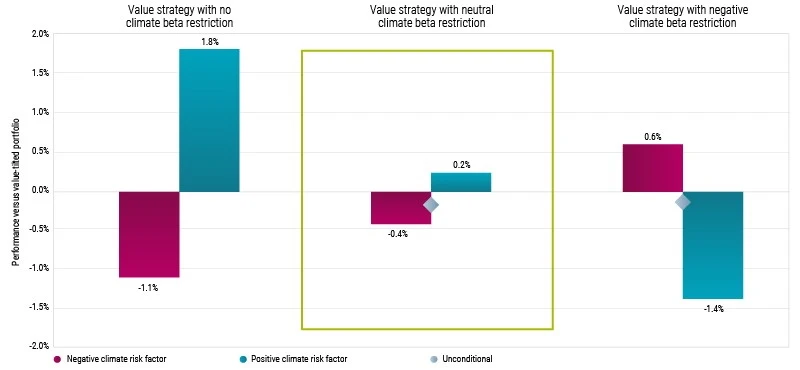In our previous ‘Indices insights’ article,1 we introduced our climate beta measure, which assesses a stock or portfolio’s exposure to the climate risk factor2 and indicates its sensitivity to climate transition risk.
This measure is useful to investors in several ways. Firstly, it complements existing climate risk indicators, with its forward-looking properties and its departure point in market rather than self-reported data. Secondly, a climate beta is better equipped to distinguish between climate leaders and laggards compared to carbon emission data. Thirdly, it has broad coverage. As well as being used to reduce stock-specific and portfolio climate transition risks, it can also be applied, for instance, as a screen or an idea generator for fundamental research.
In this article, we examine two popular investment strategies and the effects of imposing climate beta constraints on them. We begin with value investing, which historically has focused on assets in traditional and typically more pollutive, carbon-intensive industries such as utilities, industrials and energy. This gives this strategy a higher climate transition risk, as evidenced by today’s MSCI World Value index, for example, having a significantly higher climate beta of 0.2, as opposed to the MSCI World index beta of 0.3
We then analyze a passive, market-cap weighted approach. Although the market is not as sensitive to climate transition risk as a generic value portfolio, we do see passive investors becoming increasingly concerned about their exposure to climate transition risk.
Subscribe - Indices Insights
Receive an update as soon as a new article is available with insights about sustainability, factors or markets.
Integrating climate beta in Value strategies reduces climate transition risk
To assess the effect of integrating climate beta, we look at three value approaches, leaving the first unencumbered and applying a climate beta restriction to the other two. Long-term average performance conditional on the direction of the climate risk factor allows us to better understand the strategies’ sensitivity to climate risk.
We expect the strategies with an integrated climate beta restriction to outperform the generic approach when the climate risk factor shows negative returns (i.e. ‘polluting’ stocks in the long term underperform the ‘clean’ stocks in the short term), and vice versa. Long-term unconditional performance is also examined in order to assess to what extent returns are affected when these constraints are imposed.
In Figure 1, we plot annualized returns of the portfolios with climate beta restrictions relative to our unconstrained value-tilted portfolio, conditional upon the return of the climate risk factor. We split the sample in months during which the climate risk factor return is negative (magenta) and positive (blue). As expected, we indeed find that a generic value strategy is vulnerable to climate transition risks, and its performance strongly dependent on the direction of the climate risk factor.
For instance, during months when the factor is negative, the annualized performance of the value portfolio is 1.1% lower compared to its own long-term outperformance versus the market index. In positive months, the portfolio has a 1.8% better performance (annualized) compared to its long-term average.
Figure 1 | Value investors can neutralize their portfolio’s climate transition risk without reducing returns

Source: Robeco. The sample period is from January 2011 to July 2022.
If we then apply a neutral climate beta restriction, meaning the climate beta must be zero or lower, we find that the conditional performance is very similar for periods with a negative and positive climate risk factor (0.6% difference). Imposing a climate beta restriction thus effectively reduces climate transition risk because the sensitivity towards the climate risk factor has been neutralized.
By constraining our value portfolio even further and only allowing it to have a significantly negative climate beta, we see indeed that the conditional performance during periods with a negative climate risk factor is now significantly higher than during positive climate risk factor months (2.0% annualized difference).
Importantly, if we look at the unconditional performance for the two climate beta-restricted portfolios (gray diamonds), we find that imposing such restriction does not come at the cost of reduced returns in the long run.4
Climate beta can benefit passive strategies too
To continue our analysis, we examine the returns of a passive market-cap weighted strategy with various levels of climate beta restrictions imposed, and compare these to the market-cap weighted portfolio unrestricted by climate beta (and thus always equaling zero by construction).
As can be seen in Figure 2, by imposing increasingly tighter climate beta restrictions, these market portfolios also show increasingly higher return dispersion conditional upon the direction of the climate risk factor; in other words, lower climate transition risk. Importantly, the unconditional performance is not worsened by integrating climate beta.
We conclude therefore that climate beta integration is an effective approach to reducing the climate transition risk of a market portfolio, without investors having to compromise on their long-term return objectives. This is an important discovery as it means that passive investors wishing to earn the equity premium but who are concerned with climate transition risk or wish to exploit the climate risk factor can efficiently incorporate this into a market-cap weighted approach by the integration of climate beta.
Figure 2 | Passive investors can reduce their portfolio’s climate transition risk without reducing returns

Source: Robeco. The sample period is from January 2011 until July 2022.
Data and methodology
For our analysis we use the monthly US dollar returns of MSCI World constituents for a period from January 2011, when we have a first climate beta available, to July 2022. At the end of each month, we construct the value-tilted portfolio and market-cap weighted portfolio. Based on that, we construct various climate beta-restricted portfolios by reweighting the underlying constituents such that the imposed climate beta restriction is met. Finally, we calculate the next month’s returns for the market portfolio, the value-tilted portfolio and each of the climate beta-restricted portfolios.
We construct the value-tilted portfolio by reweighting the market-cap weighted portfolio based on the book-to-price measure. First, we calculate a value Z-score by standardizing the book-to-price measure truncated at -3 and 3. This is used to calculate the value indicator, as shown below:

All stocks are reweighted by the product of their market-cap weight and their value indicator. Finally, these weights are normalized to add up to 100%.
For each month and each stock, we estimate climate betas (βClimate) by regressing 60-month stock returns on the Robeco Developed Climate Risk L/S Factor Index. These are truncated at -3 and 3. Next, we perform an optimization to construct the climate beta-restricted portfolios. Here we depart from either the market portfolio or the value-tilted portfolio, and then reweight the constituents based on their climate betas such that the active share versus the market-cap weighted or value tilted portfolio is minimized while meeting the restriction.
We look at different climate beta restrictions for the portfolios. For value we impose a neutral climate beta restriction (βClimate ≤ 0) and a negative climate beta restriction(βClimate ≤ -0.1). For the market portfolios we impose three negative climate beta restrictions: mild (βClimate ≤ -0.1), medium (βClimate ≤ -0.2) and strong (βClimate ≤ -0.3).
This gives us monthly returns for the market portfolio, the value-tilted portfolio and each of the climate beta-restricted portfolios. We then show the average conditional and unconditional performance of value-tilted portfolios relative to value’s long-term outperformance to the market portfolio. We also show conditional and unconditional performance of climate beta-restricted market-cap weighted portfolios versus the market portfolio for which there is no climate beta restriction.
Conclusion
Based on our analysis, we conclude that integrating climate beta into popular investment strategies proves to be an effective approach to lowering a portfolio’s exposure to climate risk. On one hand, a value investor typically exposed to climate transition risk can earn the value premium while neutralizing its vulnerability to climate risk. On the other, a passive investor can reduce their sensitivity to climate transition risk by integrating climate beta in their investment strategy without having to compromise on long-term return expectations.
The Indices insights series provides new insights focused on index investing, particularly on the topics of sustainable investing, factor investing and/or thematic investing. The articles are written by the Sustainable Index Solutions team and often in close cooperation with a Robeco specialist in the field. The team has vast experience in research and portfolio management and has been designing sustainable, factor and thematic indices since 2015 for a large variety of clients: sovereign wealth funds, pension funds, insurers, global investment consultants, asset managers and private banks. The team can also tailor sustainable indices to cater to client-specific needs. For more information please visit our website Sustainable Index Solutions (robeco.com).
Footnotes
1 Huij, J., Lansdorp, S., Peppelenbos, L., and Markwat, T., September 2022, “Does climate beta pick up on climate risk?”, Robeco article.
2 Huij, J., Lansdorp, S., Peppelenbos, L., and Markwat, T., August 2022, “Do investors act on shifts in climate concerns?”, Robeco article. The climate risk factor is constructed by going long ‘polluting’ companies and short ‘clean’ companies and is tracked by the Robeco Developed Climate Risk LS Factor Index. See www.spglobal.com/spdji/en/custom-index-calculations/robeco-indices-bv/all/#overview.
3 Current sector positioning and climate betas are as at 31 July 2022.
4 By definition, the value tilt, as measured by the portfolios’ book-to-price ratios, deteriorates somewhat by imposing a climate beta restriction. However, we find that both the climate beta neutral portfolio and the value portfolio with significant negative climate beta still have a significant value tilt.



















